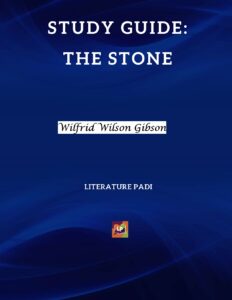🎥 We’re cooking something delicious for you on our YouTube channel. In the coming days, you will learn SSCE literature texts like you're in class 📚✍🏽
Be part of this new journey we are about to embark on.
🔔 Subscribe Now
The themes in Wilfrid Wilson Gibson’s “The Stone” are grief, silence, death, art as mourning, and transformation.
In this blog post, we are going to discuss the themes in Wilfrid Wilson Gibson’s “The Stone” and what they mean in the poem.
Themes in “The Stone”
Grief as a Slow Death
The central theme of “The Stone” is grief, but not in its typical, expressive form. Gibson presents grief as a quiet, paralysing force, one that consumes the mourner not with sobs or wailing, but with frozen silence and physical stillness. A kind of living death.
When the young woman learns of her lover’s sudden death in the quarry, her response is not emotional release but emotional shutdown. The narrator describes her transformation with stark imagery:
“And when I came, she stood alone — / A woman, turned to stone.” (ll. 30–31)
This metaphor of being “turned to stone” is key. It connects her to the splintered rock that killed her lover (l. 5) and evokes the myth of Niobe or Medusa, figures frozen by grief or punishment. The woman becomes emotionally petrified, suspended between the living and the dead.
Her condition is described in disturbingly still terms:
“She did not sigh nor moan…
She could not weep…
She could not sleep.”
(ll. 35–39)
“Three days, three nights,
She did not stir.”
(ll. 40–41)
Time loses meaning for her: “Three days, three nights, / Were one to her” (ll. 42–43). She has become unmoored from the world of the living. This state is not simply mourning; it is existential collapse.
Even her gaze becomes deathly:
“Her tearless, staring eyes,
That, seeing naught, saw all.”
This line hauntingly portrays how grief can distort perception. She is both absent from the world and hyper-aware of her pain—a state of emotional paralysis that echoes the condition of the dead.
Finally, the poem closes the circle of this slow death when the narrator reveals:
“Next night I laboured late, alone,
To cut her name upon the stone.”
(ll. 96–97)
Her physical death follows naturally, even inevitably, from the emotional death she suffered earlier.
Grief, in this poem, is not something to be endured or expressed. It is something that hollows out the mourner until nothing remains. The woman dies long before her heart stops beating.

The Unbearable Weight of Silence
The theme of silence is one of the prominent themes in “The Stone”. Wilfrid Wilson Gibson presents silence not as peace, but as a form of emotional violence—a haunting, oppressive void that follows the death of the young woman’s lover.
This silence is not the calm after mourning. It is the soundlessness of shock, paralysis, and inexpressible grief.
After the sudden accident, the girl does not speak or cry. Her transformation is immediate and total:
“A woman, turned to stone:
And, though no word at all she said,
I knew that all was known.”
(ll. 31–33)
Her silence speaks volumes. It tells of a soul so overwhelmed by pain that it can no longer process emotion. She is mute because grief has consumed the space where language used to be.
The narrator is profoundly disturbed by this:
“I could not bear to feel
Those still, grey eyes that followed me…
And curdled the warm blood in me.”
(ll. 58–62)
Her “still, unseeing stare” (l. 56) unsettles him more deeply than any outburst would have. Her presence is ghostly and heavy, and her silence creates a pressure that invades his very body: “cut me to the bone, / And cut my marrow like cold steel.” (ll. 63–64)
Even when she does speak, it is only to repeat the same quiet plea: “And will you cut a stone for him?” (ll. 1, 3, 51). The repetition of this line, delivered without emotion, becomes eerie and ritualistic. It is a refrain hollowed of feeling, driven only by the momentum of grief.
As the speaker carves the gravestone, the silence thickens:
“She never spoke
A single word:
And not a sound or murmur broke
The quiet, save the mallet stroke.”
(ll. 77–80)
This heavy quiet becomes more disturbing than any scream or sob. It is the sound of a soul shut down. In “The Stone”, grief does not shout. It watches, follows, presses in, and says nothing. And that silence is terrifying.
Get the Full Analysis in PDF
Enjoying this breakdown? What you’re reading is just part of the full experience. The premium PDF edition brings everything together in one seamless, distraction-free document that has the poem, themes, structure, and full commentary. If you’re studying seriously, this is the version you’ll want.

Theme of Death as a Persistent Presence
Death is a moment. It is an ending. But in “The Stone”, it is more. Death is a lingering, active force. Wilfrid Wilson Gibson personifies Death as a constant companion that haunts the living long after the actual passing of the girl’s lover.
This chilling presence becomes most explicit in the lines:
“And every stroke my chisel cut,
Death cut still deeper in her heart:
The two of us were chiselling,
Together, I and Death.”
(ll. 86–89)
Here, Death is not content with having claimed a life. It now participates in the act of memorialisation. As the speaker works the stone, Death works in parallel, engraving the girl’s pain deeper into her being. The metaphor is stark: the act of remembering is also an act of wounding.
Death also pervades the girl’s transformation. She is described as “A woman, turned to stone” (l. 31); “Her tearless, staring eyes… / That, seeing naught, saw all.” (ll. 47–48). Suggestively, she has joined her lover in death both spiritually and emotionally. She no longer reacts, eats, weeps, or sleeps. She becomes deathlike in posture and presence, and embodies the stillness and finality of the stone that killed him.
Even the house becomes a place haunted by living death. The speaker is “cut… to the bone” (l. 63) just by being near her. Death infects the atmosphere. It looms beside them both as he works night after night under candlelight.

Theme of Art as Mourning
Wilfrid Wilson Gibson explores how art becomes a ritual of grief as one of the important themes in “The Stone”. The speaker, tasked with carving a headstone, finds that the act of chiseling becomes far more than craftsmanship. It becomes a means of mourning, of processing sorrow through physical labour. This is made hauntingly clear in the lines:
“And every stroke my chisel cut,
Death cut still deeper in her heart:
The two of us were chiselling,
Together, I and Death.”
(ll. 86–89)
Here, the speaker’s carving is a shared ritual with Death, the silent partner at his side. Each blow of the mallet is a wound reopened. Beyond its artistic cum memorial value, the gravestone mirrors the pain that cannot be spoken.
There’s a stark irony in the material of the artwork: it is stone — the same substance that killed her lover. It is a symbol of destruction and devotion, of grief transformed into something permanent.
The woman sits in silence, night after night, watching the name being carved. She participates in a form of sacred vigil, her gaze almost a form of sculpting in itself. The art — the stone — becomes the only language left to her.
The process of mourning through art comes full circle. Her grief consumes her, and now she, too, is memorialised in the very same stone.
In short, art, in this poem, is a solemn inscription of sorrow that preserves the emotional weight of loss.
Theme of Transformation
Transformation is one of the discernible themes in “The Stone”. The poem is deeply concerned with how grief can utterly transform those it touches.
The most striking transformation in the poem is that of the bereaved woman, who is depicted as “a woman, turned to stone.” (l. 31) This metaphor carries layered meaning: it conveys her emotional paralysis and numbness, and also suggests that her identity has been fossilised by trauma.
After hearing of her lover’s sudden death, she doesn’t scream, cry, or collapse. She becomes suspended in a state beyond typical grief. She becomes an embodiment of mourning itself, stripped of all ordinary human responses. Her transformation is so severe that time and physical needs become meaningless.
But she is not the only one transformed.
The narrator, too, undergoes a subtle yet powerful change. Initially just a bearer of news, he becomes something more: a mediator between life and death, an unwitting sculptor of sorrow. Her grief reshapes him just as surely as he reshapes the stone.
Finally, the woman’s transformation is completed through symbolic death with the engraving of her name “upon the stone” (l. 97).
Transformation is not redemptive in “The Stone”. It is a slow, silent, irreversible process. It is grief that calcifies into identity, and turns the living into monuments of their own loss.
Related:
Receive Literary Updates through our Social Media Channels:
- WhatsApp: Literature PADI
- Telegram: Literature PADI
- YouTube: @literaturepadi
- Facebook: Literature PADI





